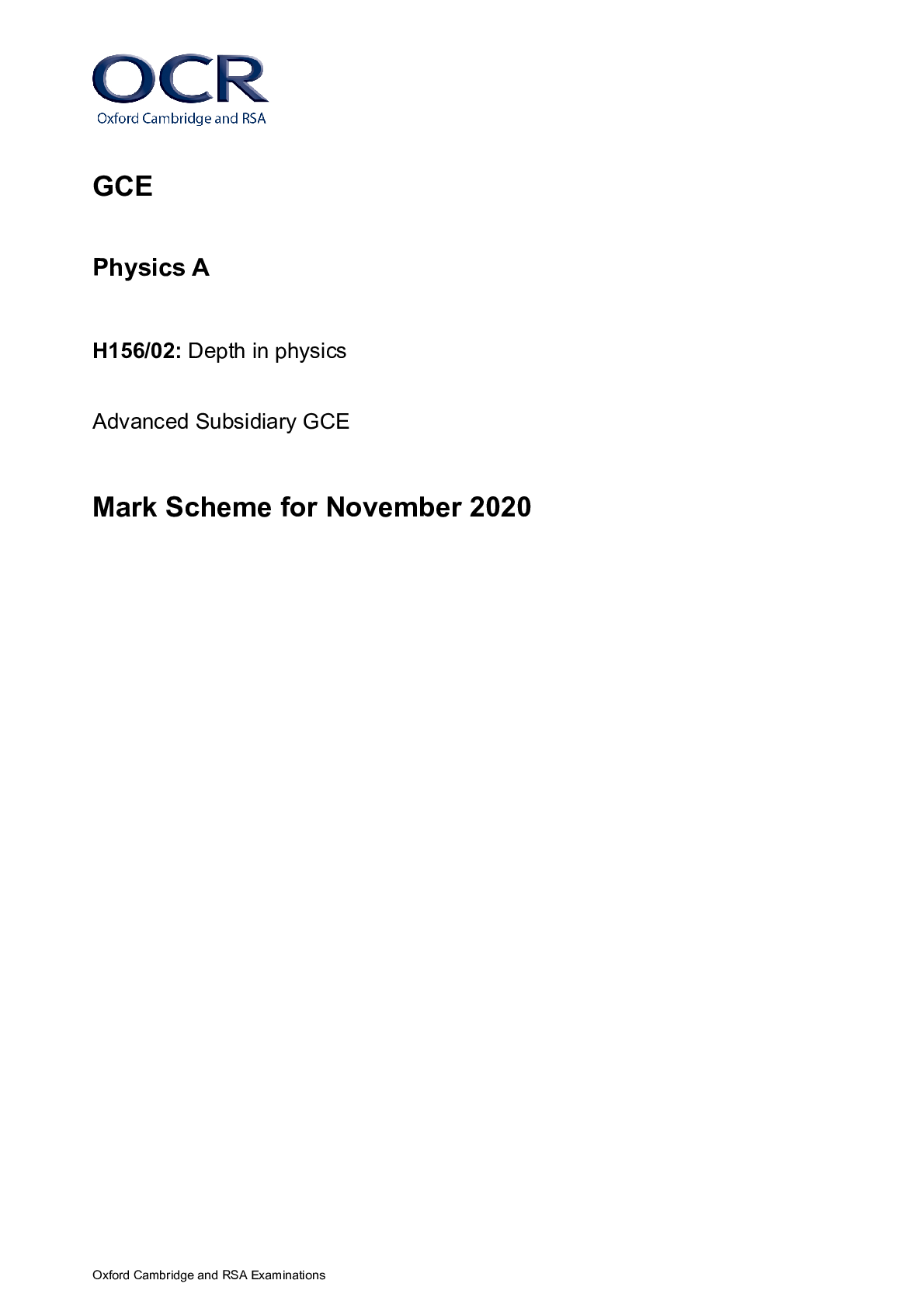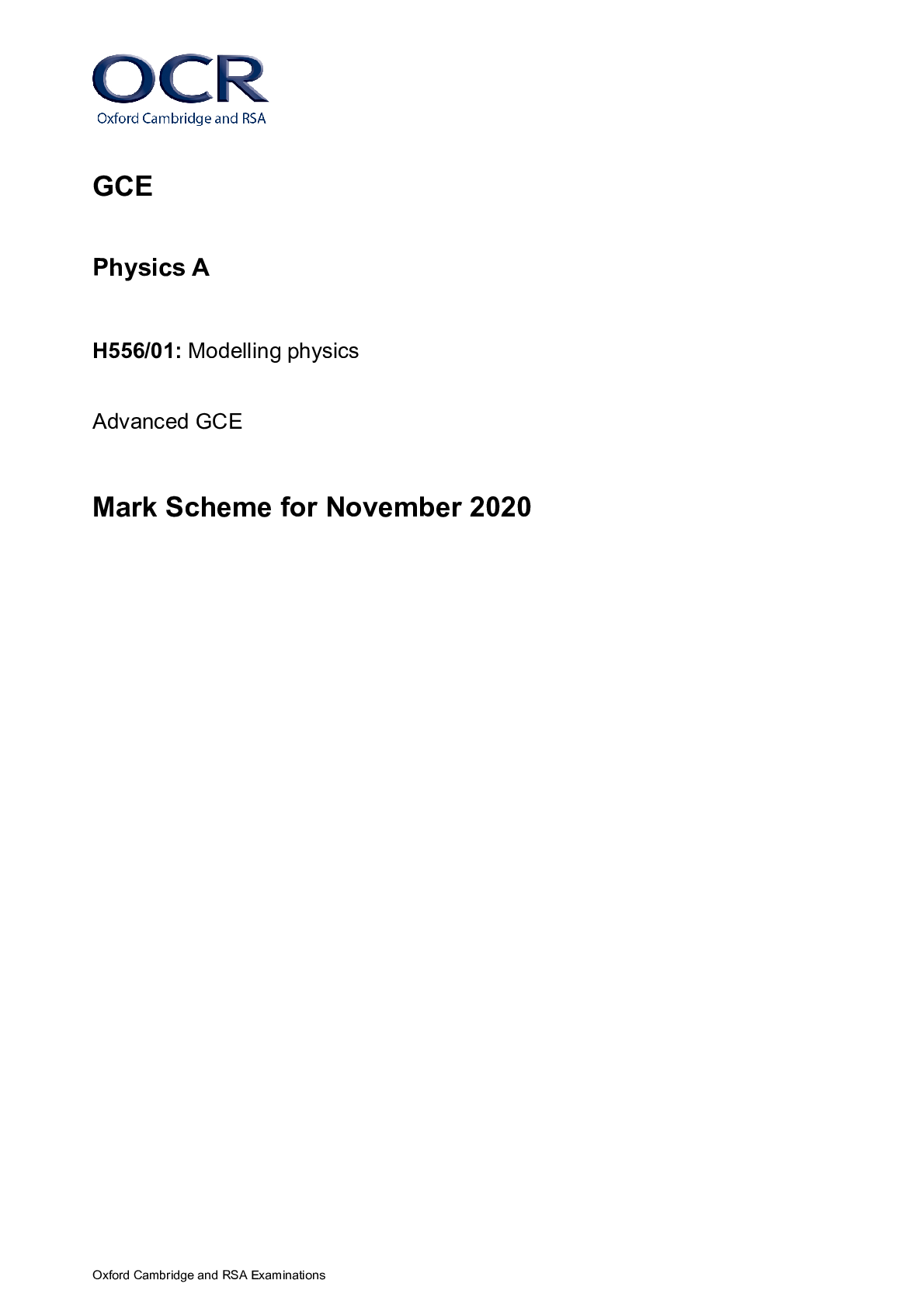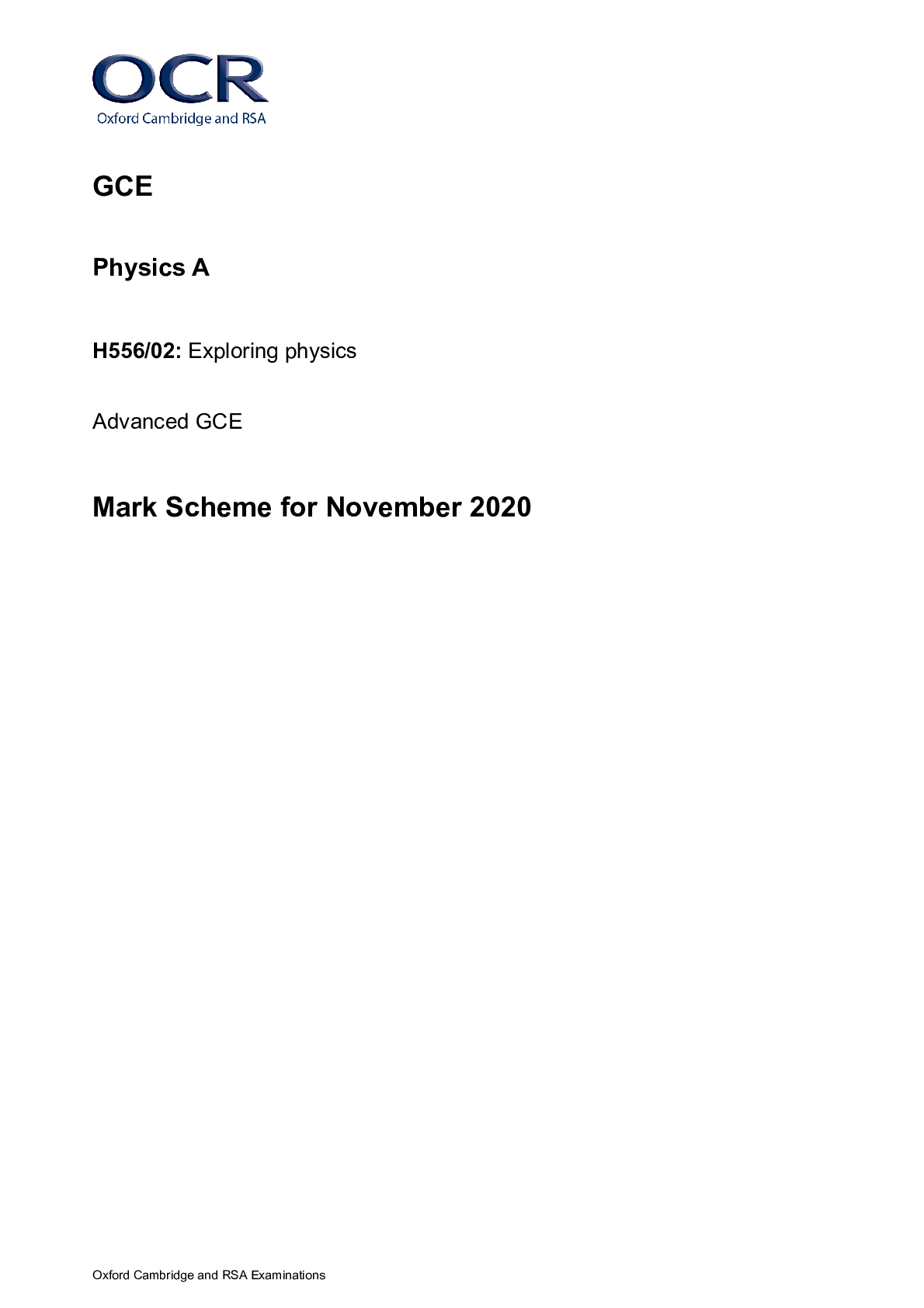Mathematics > AS Mark Scheme > GCE Further Mathematics A Y544/01: Discrete Mathematics Advanced GCE Mark Scheme for November 2020 (All)
GCE Further Mathematics A Y544/01: Discrete Mathematics Advanced GCE Mark Scheme for November 2020
Document Content and Description Below
Oxford Cambridge and RSA Examinations GCE Further Mathematics A Y544/01: Discrete Mathematics Advanced GCE Mark Scheme for November 2020Oxford Cambridge and RSA Examinations OCR (Oxford Cambridg... e and RSA) is a leading UK awarding body, providing a wide range of qualifications to meet the needs of candidates of all ages and abilities. OCR qualifications include AS/A Levels, Diplomas, GCSEs, Cambridge Nationals, Cambridge Technicals, Functional Skills, Key Skills, Entry Level qualifications, NVQs and vocational qualifications in areas such as IT, business, languages, teaching/training, administration and secretarial skills. It is also responsible for developing new specifications to meet national requirements and the needs of students and teachers. OCR is a not-for-profit organisation; any surplus made is invested back into the establishment to help towards the development of qualifications and support, which keep pace with the changing needs of today’s society. This mark scheme is published as an aid to teachers and students, to indicate the requirements of the examination. It shows the basis on which marks were awarded by examiners. It does not indicate the details of the discussions which took place at an examiners’ meeting before marking commenced. All examiners are instructed that alternative correct answers and unexpected approaches in candidates’ scripts must be given marks that fairly reflect the relevant knowledge and skills demonstrated. Mark schemes should be read in conjunction with the published question papers and the report on the examination. © OCR 2020Y544/01 Mark Scheme November 2020 Text Instructions 1. Annotations and abbreviations Annotation in RM assessor Meaning and BOD Benefit of doubt FT Follow through ISW Ignore subsequent working M0, M1 Method mark awarded 0, 1 A0, A1 Accuracy mark awarded 0, 1 B0, B1 Independent mark awarded 0, 1 SC Special case ^ Omission sign MR Misread BP Blank Page Seen Highlighting Other abbreviations in mark scheme Meaning dep* Mark dependent on a previous mark, indicated by *. The * may be omitted if only one previous M mark cao Correct answer only oe Or equivalent rot Rounded or truncated soi Seen or implied www Without wrong working AG Answer given awrt Anything which rounds to BC By Calculator DR This question included the instruction: In this question you must show detailed reasoning.Y544/01 Mark Scheme November 2020 2. Subject-specific Marking Instructions for A Level Mathematics A a Annotations must be used during your marking. For a response awarded zero (or full) marks a single appropriate annotation (cross, tick, M0 or ^) is sufficient, but not required. For responses that are not awarded either 0 or full marks, you must make it clear how you have arrived at the mark you have awarded and all responses must have enough annotation for a reviewer to decide if the mark awarded is correct without having to mark it independently. It is vital that you annotate standardisation scripts fully to show how the marks have been awarded. Award NR (No Response) - if there is nothing written at all in the answer space and no attempt elsewhere in the script - OR if there is a comment which does not in any way relate to the question (e.g. ‘can’t do’, ‘don’t know’) - OR if there is a mark (e.g. a dash, a question mark, a picture) which isn’t an attempt at the question. Note: Award 0 marks only for an attempt that earns no credit (including copying out the question). If a candidate uses the answer space for one question to answer another, for example using the space for 8(b) to answer 8(a), then give benefit of doubt unless it is ambiguous for which part it is intended. b An element of professional judgement is required in the marking of any written paper. Remember that the mark scheme is designed to assist in marking incorrect solutions. Correct solutions leading to correct answers are awarded full marks but work must not always be judged on the answer alone, and answers that are given in the question, especially, must be validly obtained; key steps in the working must always be looked at and anything unfamiliar must be investigated thoroughly. Correct but unfamiliar or unexpected methods are often signalled by a correct result following an apparently incorrect method. Such work must be carefully assessed. When a candidate adopts a method which does not correspond to the mark scheme, escalate the question to your Team Leader who will decide on a course of action with the Principal Examiner. If you are in any doubt whatsoever you should contact your Team Leader.Y544/01 Mark Scheme November 2020 c The following types of marks are available. M A suitable method has been selected and applied in a manner which shows that the method is essentially understood. Method marks are not usually lost for numerical errors, algebraic slips or errors in units. However, it is not usually sufficient for a candidate just to indicate an intention of using some method or just to quote a formula; the formula or idea must be applied to the specific problem in hand, e.g. by substituting the relevant quantities into the formula. In some cases the nature of the errors allowed for the award of an M mark may be specified. A method mark may usually be implied by a correct answer unless the question includes the DR statement, the command words “Determine” or “Show that”, or some other indication that the method must be given explicitly. A Accuracy mark, awarded for a correct answer or intermediate step correctly obtained. Accuracy marks cannot be given unless the associated Method mark is earned (or implied). Therefore M0 A1 cannot ever be awarded. B Mark for a correct result or statement independent of Method marks. Unless otherwise indicated, marks once gained cannot subsequently be lost, e.g. wrong working following a correct form of answer is ignored. Sometimes this is reinforced in the mark scheme by the abbreviation isw. However, this would not apply to a case where a candidate passes through the correct answer as part of a wrong argument. d When a part of a question has two or more ‘method’ steps, the M marks are in principle independent unless the scheme specifically says otherwise; and similarly where there are several B marks allocated. (The notation ‘dep*’ is used to indicate that a particular mark is dependent on an earlier, asterisked, mark in the scheme.) Of course, in practice it may happen that when a candidate has once gone wrong in a part of a question, the work from there on is worthless so that no more marks can sensibly be given. On the other hand, when two or more steps are successfully run together by the candidate, the earlier marks are implied and full credit must be given. e The abbreviation FT implies that the A or B mark indicated is allowed for work correctly following on from previously incorrect results. Otherwise, A and B marks are given for correct work only – differences in notation are of course permitted. A (accuracy) marks are not given for answers obtained from incorrect working. When A or B marks are awarded for work at an intermediate stage of a solution, there may be various alternatives that are equally acceptable. In such cases, what is acceptable will be detailed in the mark scheme. If this is not the case please, escalate the question to your Team Leader who will decide on a course of action with the Principal Examiner. Sometimes the answer to one part of a question is used in a later part of the same question. In this case, A marks will often be ‘follow through’. In such cases you must ensure that you refer back to the answer of the previous part question even if this is not shown within the image zone. You may find it easier to mark follow through questions candidate-by-candidate rather than question-by-question. f We are usually quite flexible about the accuracy to which the final answer is expressed; over-specification is usually only penalised where the scheme explicitly says so. • When a value is given in the paper only accept an answer correct to at least as many significant figures as the given value. • When a value is not given in the paper accept any answer that agrees with the correct value to 3 s.f. unless a different level of accuracy has been asked for in the question, or the mark scheme specifies an acceptable range. NB for Specification B (MEI) the rubric is not specific about the level of accuracy required, so this statement reads “2 s.f”.Y544/01 Mark Scheme November 2020 Follow through should be used so that only one mark in any question is lost for each distinct accuracy error. Candidates using a value of 9.80, 9.81 or 10 for g should usually be penalised for any final accuracy marks which do not agree to the value found with 9.8 which is given in the rubric. g Rules for replaced work and multiple attempts: • If one attempt is clearly indicated as the one to mark, or only one is left uncrossed out, then mark that attempt and ignore the others. • If more than one attempt is left not crossed out, then mark the last attempt unless it only repeats part of the first attempt or is substantially less complete. • if a candidate crosses out all of their attempts, the assessor should attempt to mark the crossed out answer(s) as above and award marks appropriately. h For a genuine misreading (of numbers or symbols) which is such that the object and the difficulty of the question remain unaltered, mark according to the scheme but following through from the candidate’s data. A penalty is then applied; 1 mark is generally appropriate, though this may differ for some units. This is achieved by withholding one A or B mark in the question. Marks designated as cao may be awarded as long as there are no other errors. If a candidate corrects the misread in a later part, do not continue to follow through. Note that a miscopy of the candidate’s own working is not a misread but an accuracy error. i If a calculator is used, some answers may be obtained with little or no working visible. Allow full marks for correct answers, provided that there is nothing in the wording of the question specifying that analytical methods are required such as the bold “In this question you must show detailed reasoning”, or the command words “Show” or “Determine”. Where an answer is wrong but there is some evidence of method, allow appropriate method marks. Wrong answers with no supporting method score zero. If in doubt, consult your Team Leader. j If in any case the scheme operates with considerable unfairness consult your Team Leader.Y544/01 Mark Scheme November 2020 Question Answer Mark Guidance 1 For reference: 1 (a) (i) (a sub-division of) K3,3 is not a subgraph since there are only 5 vertices with degree ≥ 3 B1 Explaining why K3,3 is not a subgraph (not just stating it) (a sub-division of) K5 is not a subgraph since there are only 3 vertices with degree (≥) 4 Hence graph is planar B1 Explaining why K5 is not a subgraph (not just stating it) Conclusion may be implied SC B1 for saying 2 vertices with degree 2 but not referring to total number of vertices Kuratowski is asked for in question, so just describing e.g. ‘moving arc BG so that it is outside’ gets no credit [2] 1 (a) (ii) 7 + R = 11 + 2 ⇒ R = 6 B1 Correct use of V + R = E + 2 leading to answer 6 Answer 6 with no evidence of Euler ⇒ B0 [1] 1 (b) (i) e.g. A – B – D – E – G – F – C – A e.g. A – B – G – E – D – F – C – A B1 One of these (or in reverse) with any starting point Cycle must be closed and must pass through all 7 vertices [1] 1 (b) (ii) e.g. A and G are non-adjacent M1 Any two non-adjacent vertices and their degrees (or sum) provided degrees sum to 5 or 6 (but not greater than 6) deg(A) + deg (G) = 2 + 3 = 5 < 7 (= n) A1 Showing that degree sum is not ≥ 7 (compare with 7) [2]Y544/01 Mark Scheme November 2020 1 (c) (i) B1 Graph with AB and CF contracted (and labelled using this notation) [1] 1 (c) (ii) Only non-adjacent vertices are D and G deg(D) + deg(G) = 3 + 3 = 6 M1 D and G have degree sum = 6 n = 5 vertices and 6 is greater than 5 Hence result A1 Showing that degree sum is > 5 (compare with 5) 6 ≥ 5 or 6 > 5, or equivalent, or in words [2] 2 (a) (i) R S T Row min for A K (7, 3) (2, 6) (5, 3) 2 L (1, 5) (8, 2) (2, 5) 1 M (3, 2) (1, 5) (4, 6) 1 B1 May reduce every a value by a constant and/or every b value by a constant, but not e.g. reducing rows and not calculating differences, a – b Row minima 2, 1, 1 (o.e.) seen, on table or written But not just stating row maximin = 2 Play-safe strategy for Annie is K B1 K identified as play-safe [2] 2 (a) (ii) R S T K (7, 3) (2, 6) (5, 3) L (1, 5) (8, 2) (2, 5) M (3, 2) (1, 5) (4, 6) Col min for B 2 2 3 M1 May reduce every a value by a constant and/or every b value by a constant, but not e.g. reducing rows and not calculating differences, a – b Col minina 2, 2, 3 (o.e.) seen, on table or written T has largest minimum Maximin = max {2, 2, 3} = 3 (so play-safe for Brett is T, as given) A1 Col maximin = 3 ‘max’ or ‘largest’ [2]Y544/01 Mark Scheme November 2020 Question Answer Mark Guidance 2 (b) (i) K B1 K [1] 2 (b) (ii) S B1 FT Follow through to col with max b value in row from (b)(i) [1] 2 (c) (Column R is weakly dominated by) column T M1 T (only) 3 = 3, 5 = 5 and 2 < 6 A1 3, 3 5, 5 and 2 < 6 [2] 2 (d) Let Brett play S with probability p and T with probability 1 – p If Annie plays X, Brett expects to win 6p + 3(1 – p) = 3 + 3p If Annie plays Y, Brett expects to win 2p + 5(1 – p) = 5 – 3p If Annie plays Z, Brett expects to win 5p + 6(1 – p) = 6 – p B1 Three correct expressions (in any form) for expected winnings in terms of a single variable (which need not be called p) B1 Graph showing lines (0, 3) to (1, 6) (0, 5) to (1, 2) and (0, 6) to (1, 5) Horizontal axis from 0 to 1 using at least half width of grid (values 0 and 1 may be implied from lines) Vertical axis with a scale (at least 2 values marked on axis, or origin and at least 1 value marked) Optimum at p = 1 3 M1 1 3 or prob corresponding to max point of their lower boundary Play S with probability 1 3 and T with probability 2 3 A1FT Interpretation of their p in context, or implied if meaning of p (or 1 – p) was given when setting up equations [4] 2 (e) Best outcome in each col for Annie: (K, R), (L, S), (K, T) B1 (K, R), (L, S) and (K, T) identified as a set in any way Best outcome in each row for Brett: (K, S), (L, R), (L, T), (M, T) B1 (K, S), (L, R), (L, T) and (M, T) identified as a set in any way No common cell so no Nash equilibrium Or one set and verify none of these are optimal for other player R S T R S T K (7, 3) (2, 6) (5, 3) K (7, 3) (2, 6) (5, 3) L (1, 5) (8, 2) (2, 5) L (1, 5) (8, 2) (2, 5) M (3, 2) (1, 5) (4, 6) M (3, 2) (1, 5) (4, 6) [2]Y544/01 Mark Scheme November 2020 Question Answer Mark Guidance 3 For reference: P x y z s t RHS 1 –3 1 0 0 0 0 0 2 0 1 1 0 18 0 –1 2 3 0 1 20 3 (a) Maximise P = 3x – y B1 3x – y B1 Max P [2] 3 (b) Slack variables are added to ≤ inequalities to form equations M1 An appropriate description about removing inequalities –x + 2y + 3z ≤ 20 becomes –x + 2y + 3z + t = 20, where t ≥ 0 A1 –x + 2y + 3z ≤ 20 or –x + 2y + 3z + t = 20 (allow a different letter is used for slack variable) [2] 3 (c) Pivot on 2 in x column B1 Pivot choice stated or indicated on tableau (not just implied) (x column and value 2 or x column and middle row) P x y z s t RHS 1 0 1 1.5 1.5 0 27 0 1 0 0.5 0.5 0 9 0 0 2 3.5 0.5 1 29 M1 M1 A1 Their pivot row divided through by their positive pivot value A tableau with basis cols P, their pivot col and either s or t in which the values in the final col are non-negative A correct tableau P = 27 B1 27 x = 9, y = 0, z = 0 M1 Reading off ≥ 0 x, y, z values from their final tableau, not all 0 A1 (9, 0, 0) oe Moves along an edge of a convex polyhedron (or 3-dimensional convex polygon) or along the x-axis in 3-dimensional space (from the origin to (9, 0, 0)) B1 ‘edge’ or ‘x-axis’ (not just implied from coordinates) and 3 dimensions (which may be implied from coordinates stated) [8]Y544/01 Mark Scheme November 2020 Question Answer Mark Guidance 4 (a) 28 = 256 ways to assign 8 items to 2 sets Order does not matter so divide by 2 M1 28 (or 256) and later dividing by 2 Cannot have a set of size 0 and a set of size 8 M1 Dealing with the case(s) where one set is empty Total = 127 (as given) A1 To achieve 127 from valid reasoning Alternative method Set of 1 and set of 7 = 8C1 = 8 ways Set of 2 and set of 6 = 8C2 = 28 ways Set of 3 and set of 5 = 8C3 = 56 ways M1 8 ways to partition as a set of size 1 and a set of size 7 (or any other 8Cr evaluated, where r = 2, 3, 4, 5 or 6) Two sets of 4 = 8C4 ÷ 2 = 35 ways M1 Dividing by 2, including 8C4 ÷ 2 = 35 Total = 127 (as given) A1 To achieve 127 from valid reasoning [3] 4 (b) 8 × 7 × 6 × 5 M1 Or attempt at 8P4 or (4! × 8C4) =1680 A1 1680 [2] 4 (c) Seat 5 F H G F G H F G H Seat 6 E E E H H G G H G Seat 7 H F H E E E H F F Seat 8 G G F G F F E E E M1 All nine columns completed Each column contains all four letters, even if people are in their designated seat(s) or there are repeated columns At least three different columns M1 At least three different correct derangements A1 All nine correct (in any order) [3] 4 (d) 8C4 = 70 ways to choose four people to be in correct seats M1 Appropriate use of 8C4 9 derangements of the other four people 70 × 9 = 630 A1 630 [2]Y544/01 Mark Scheme November 2020 Question Answer Mark Guidance 5 For reference: AB AC AD AE BC BD BE CD CE DE 300 500 900 700 200 600 400 500 - 100 5 (a) D – E – B – C |A M1 Any spanning tree for the 5 vertices May list arcs included rather than drawing tree, oe £1000 A1 1000 (cao) [2] 5 (b) (i) Lower bound for TSP Deleting A: MST = 700 700 + 300 + 500 = 1500 M1 Weight of any one of these reduced MST’s seen Deleting B: MST = 1100 1100 + 200 + 300 = 1600 Deleting C: MST = 800 800 + 200 + 500 = 1500 Deleting D: MST = 900 900 + 100 +500 = 1500 Deleting E: MST = 1000 1000 + 100 + 400 = 1500 A1 A correct calculation of ‘MST + two least weight arcs from deleted vertex’ A1 Their best (greatest) lower bound (with all 5 totals given) Best lower bound = £1600 B1 1600 (cao) [4] 5 (ii) Nearest neighbour method A – B – C – D – E – A = 1800 B – C – D – E – A – B = 1800 M1 Nearest neighbour (even if not closed, but visiting all 5 vertices) for at least one starting point, or implied from a correct total C – B – A – E – D – C = 1800 D – E – B – C – A – D = 2100 E – D – C – B – A – E = 1800 A1 At least three correct totals A1 Their best (least) upper bound (with all 5 totals given) Best upper bound = £1800 B1 1800 (cao) [4] 5 (iii) A – B – C – D – E – A M1 First three vertices correct, for any starting point and direction A1FT Correct cycle, or in reverse, with any starting point Or FT cycle seen in answer to (b)(ii) if UB ≠ 1800 [2] 5 (c) Need to pave a route from the shop to the first field B1 Connect to shop, fields are not points, or other valid reason [1] 5 (d) (i) A – C – E – D (or A–B–C–E–D) < 900 M1 Shortest route including CE, or implied from cost www so cost of CE < £300 A1 300 (or 299.99, 299, 290) [2] 5 (d) (ii) MST = CE + ED + CB + BA (CE replaces BE) M1 MST including CE, or implied from cost www £600 + cost of CE < £900 A1FT 900 (or 899.99, 899, 890), follow through their 300 from (d)(i) [2]Y544/01 Mark Scheme November 2020 Question Answer Mark Guidance 6 For reference: 6 (a) (i) Event Early time 0 2 4 4 7 10 10+x 15 M1 Forward pass, early event times at every vertex, shown on network or listed (increasing from 0) A1 All correct, apart possibly from 0 ≤ x ≤ 3 B1 ≤ 3 [3] 6 (a) (ii) Event Late time 0 3 4 4 7 10 13 15 M1 Backward pass, late event times at every vertex (decreasing, with start and finish matching the forward pass) A1 All correct, may have max{12+x, 15}or 12+x, 15 at A, F, H, K B1 A, F, H, K Allow A, F, H, I, J, K (with both I and J) but no others [3] 6 (b) Max value for n is 2 B1 2 For reference: Activity A B C D E F G H I J K Workers 2 1 1 2 n 1 2 1 1 1 4 2 do A while another does B then C 4 workers do K while the other does I then J D, (E), F, G and H must be completed between time 4 and time 10 G needs 2 workers M1* Reasoning may be seen on grids D, F, G and H must be done between time 4 and time 10 so 3 workers are available for D, (E), F and H M1dep* 3 workers available for D, F and H (or implied from E followed by D or vice versa) G takes 5 minutes F followed by H uses 1 worker for 6 minutes E can be fitted in before D so only 2 workers are needed A1 E done before D [4]Y544/01 Mark Scheme November 2020 Question Answer Mark Guidance (c) 18 minutes B1 18 or 18 + x Time 0 2 4 6 8 11 16 Start A, B C E, F, D G H K I, J (n = 1) (x = 0) Working is not necessary but may be seen on grids [1] (d) 0 minutes B1FT Their answer to part c minus 18 Working is not necessary but may be seen on grids [1] (e) 1 worker B1 1 Working is not necessary but may be seen on grids [1]OCR (Oxford Cambridge and RSA Examinations) The Triangle Building Shaftesbury Road Cambridge CB2 8EA OCR Customer Contact Centre [Show More]
Last updated: 1 year ago
Preview 1 out of 15 pages
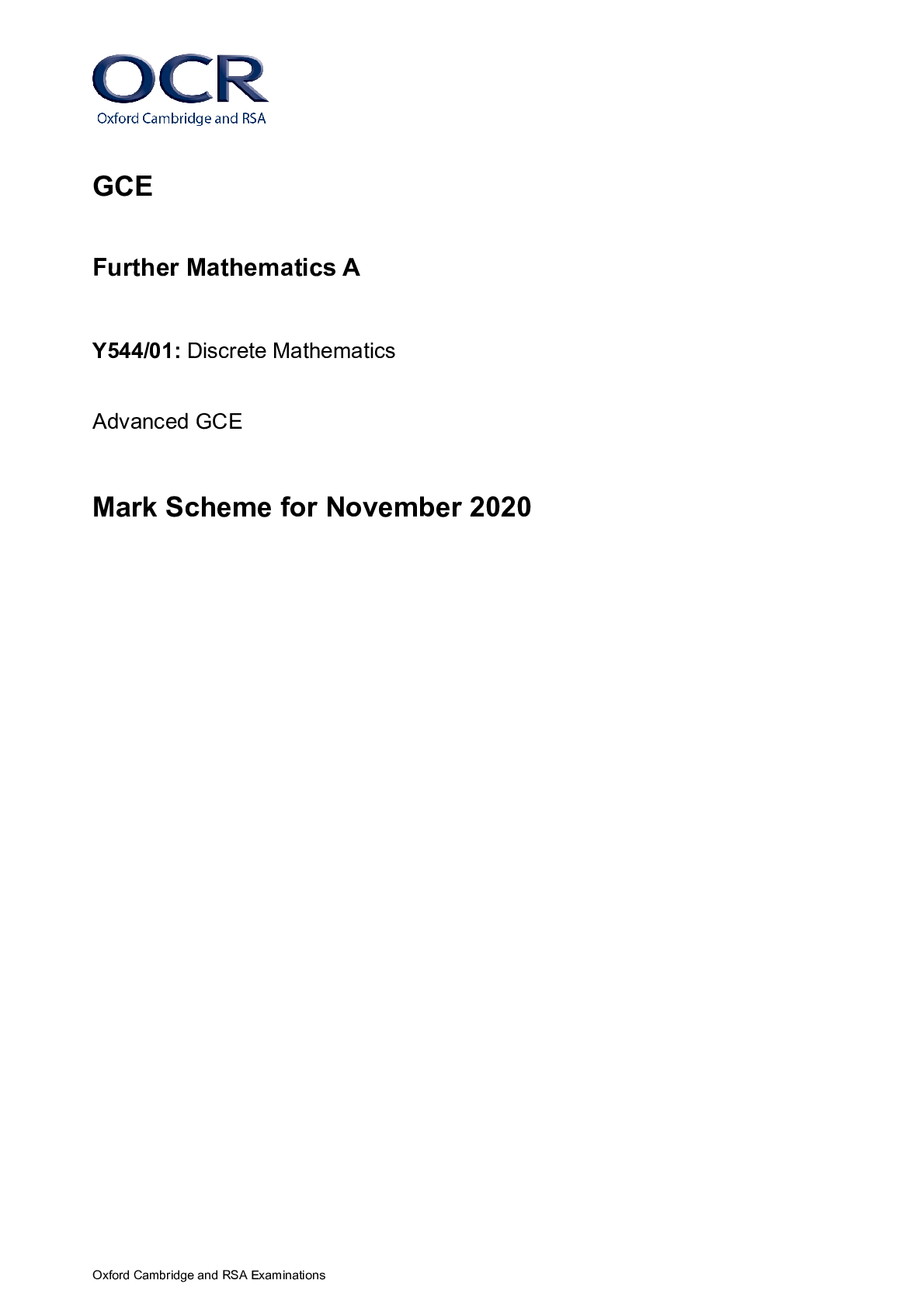
Buy this document to get the full access instantly
Instant Download Access after purchase
Add to cartInstant download
We Accept:

Reviews( 0 )
$6.50
Document information
Connected school, study & course
About the document
Uploaded On
Oct 10, 2022
Number of pages
15
Written in
Additional information
This document has been written for:
Uploaded
Oct 10, 2022
Downloads
0
Views
79

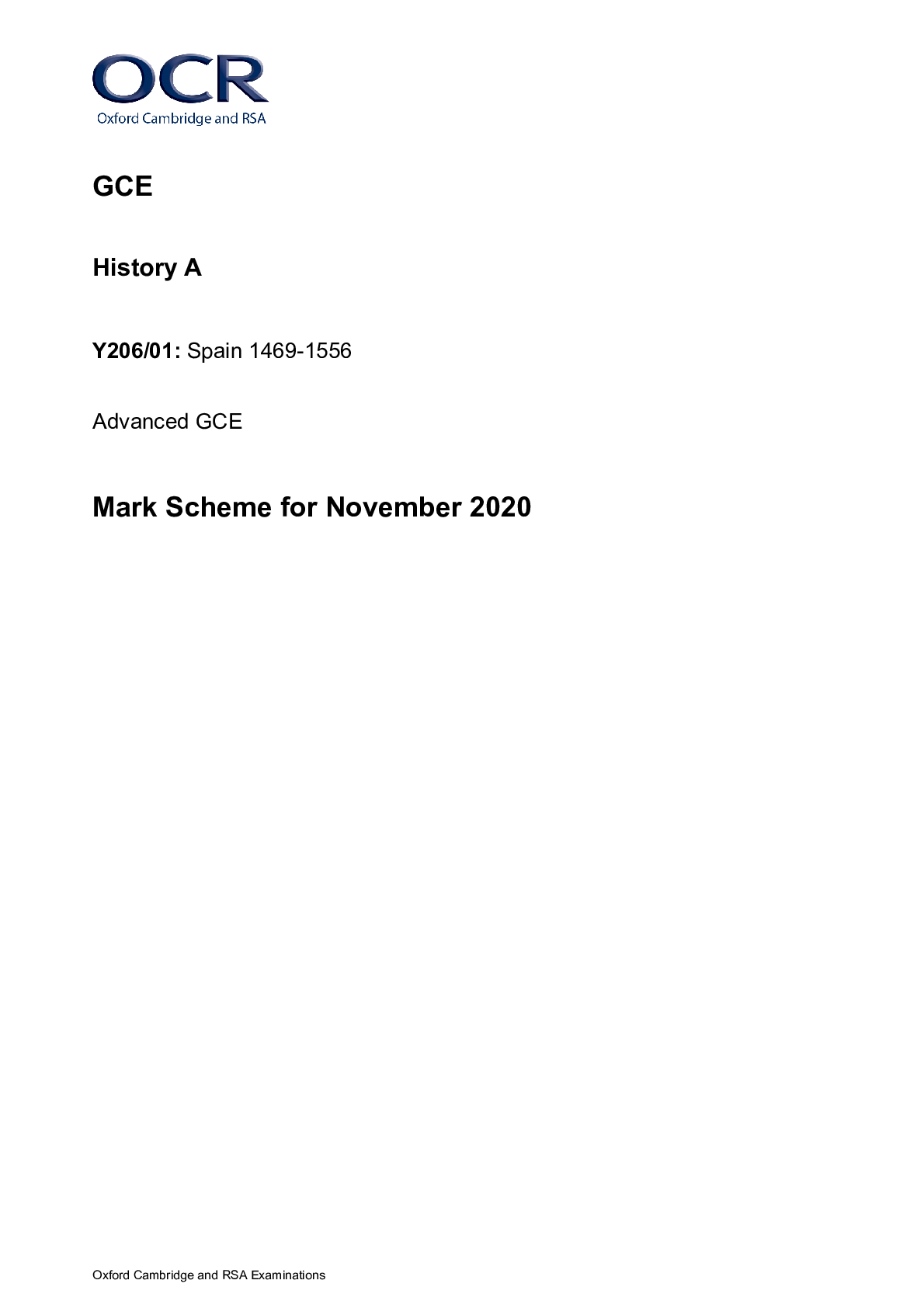
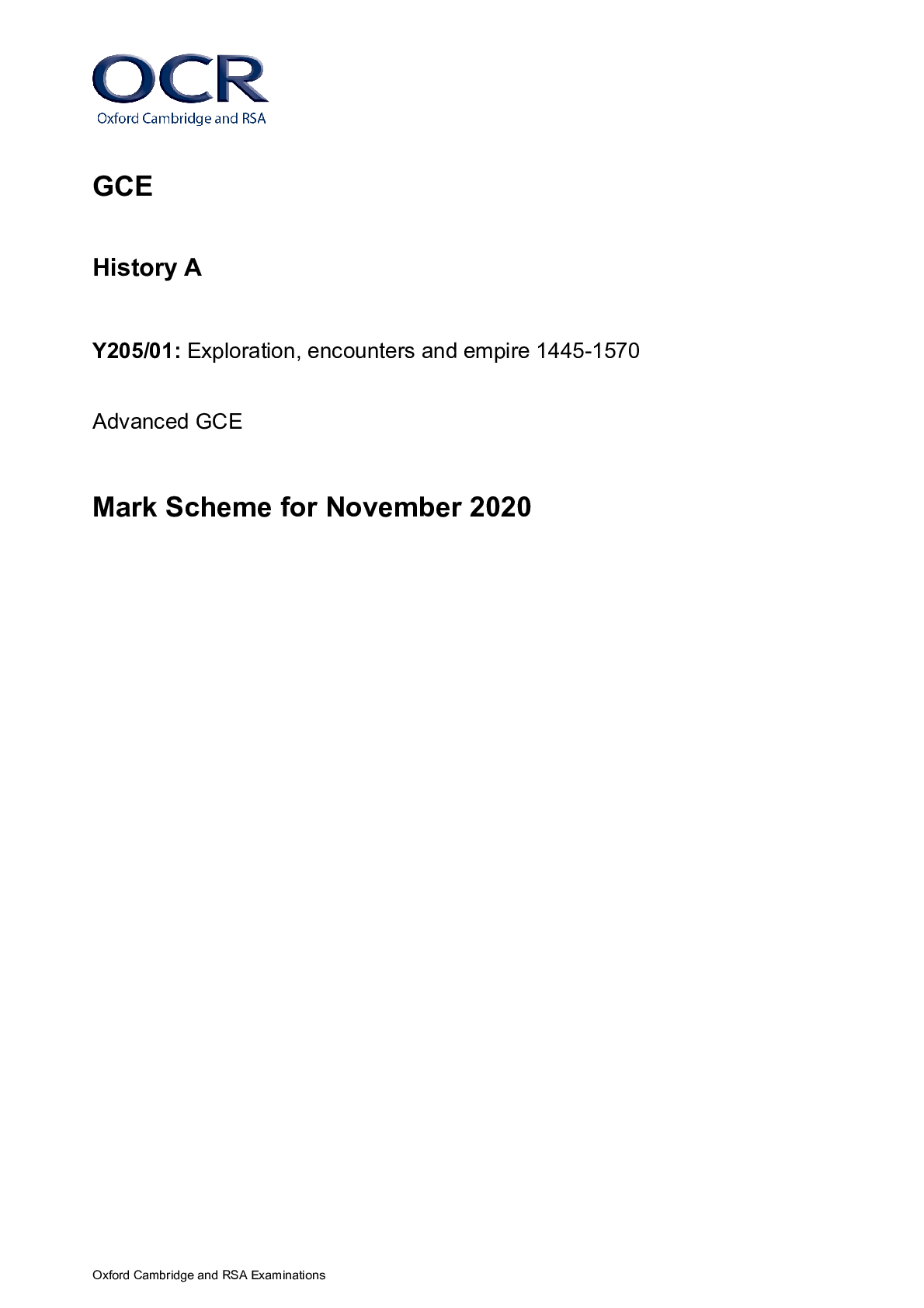






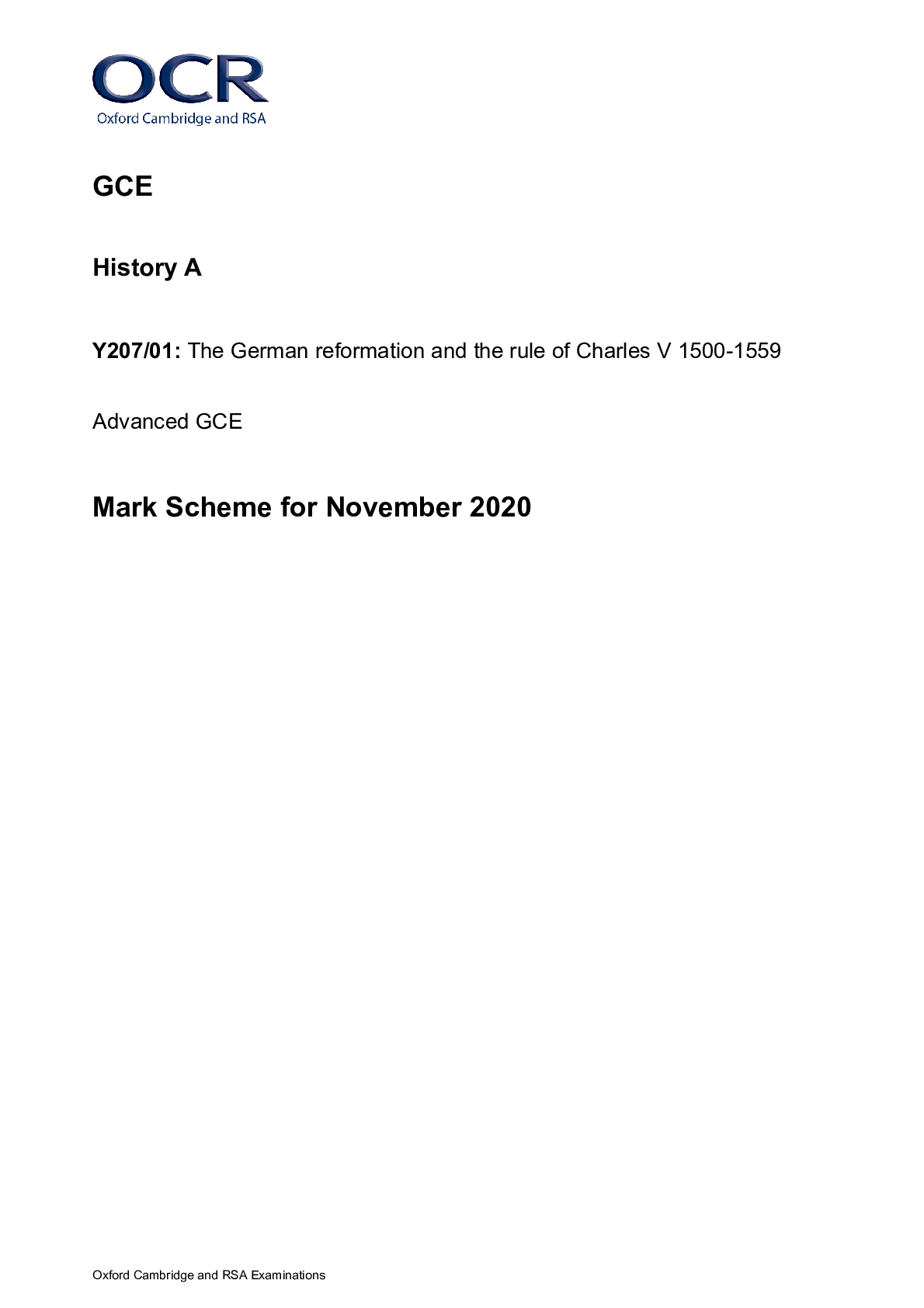






.png)



